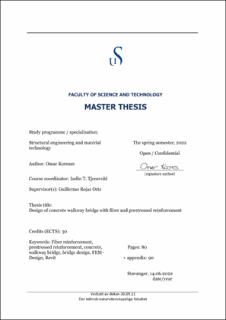| dc.description.abstract | The advances made in the field of prestressed concrete have widened the freedom in building structures. This allows achieving high loading capacity with the adaption of longer spans and smaller cross-section dimensions. Post-tensioning technique of prestressing is the most adopted method by the industry due to many advantages.
Fiber reinforcement improves the material properties of the concrete through increased general tenacity, reduction of crack widths, and a well-documented increase of shear capacity. (Kanstad, et al., 2020) However, fiber-reinforced concrete is rarely used in load-bearing structures due to lack of experience and guidelines. Its use may increase as the Norwegian Concrete Association's recently published publication no. 38 ‘’Fiber-reinforced concrete in load-bearing structures’’ (NB38) provides guidance in the use of fiber concrete.
Post tensioning reinforcement combined with fiber reinforced high strength concrete is the foundation on which a walkway bridge for this thesis is designed as a study case. It is designed after NB38 combined with the newest draft of EN1992-1-1 with Annex L for fiber reinforcement. The draft of the standard is used for experimental reasons and with interest in looking at future design principles. The thesis examines the potential of designing structural elements with small cross-sections that leads to aesthetically pleasing structures with opportunity to decrease material use and the use of extra reinforcement.
The standards have a required minimum amount of reinforcement for constructions where a collapse can lead to loss of human life or cause large social costs. It is concluded that over half the volume of concrete used for the bridge elements does not need more reinforcement than the minimum, and thus a great deal of reinforcement steel is saved. This leads to significant economic and environmental benefits and points to the advantages of fiber reinforced and prestressed concrete.
The structural design of the bridge is based on similar bridges such as (Lopez, et al., 2015) and (di Prisco, et al., 2022) that both are interesting projects with the implementation of a post-tensioned fiber reinforced concrete. Bridges like these are implementing ultra-high strength concrete, with strengths up to 𝑓𝑐𝑘=150 𝑀𝑃𝑎. However, with the prerequisites of the thesis to be NB38 in combination with the Eurocode draft, the concrete strength has been reduced to an appropriate value of 𝑓𝑐𝑘=100 𝑀𝑃𝑎 to be eligible with formulas from this literature. | |
